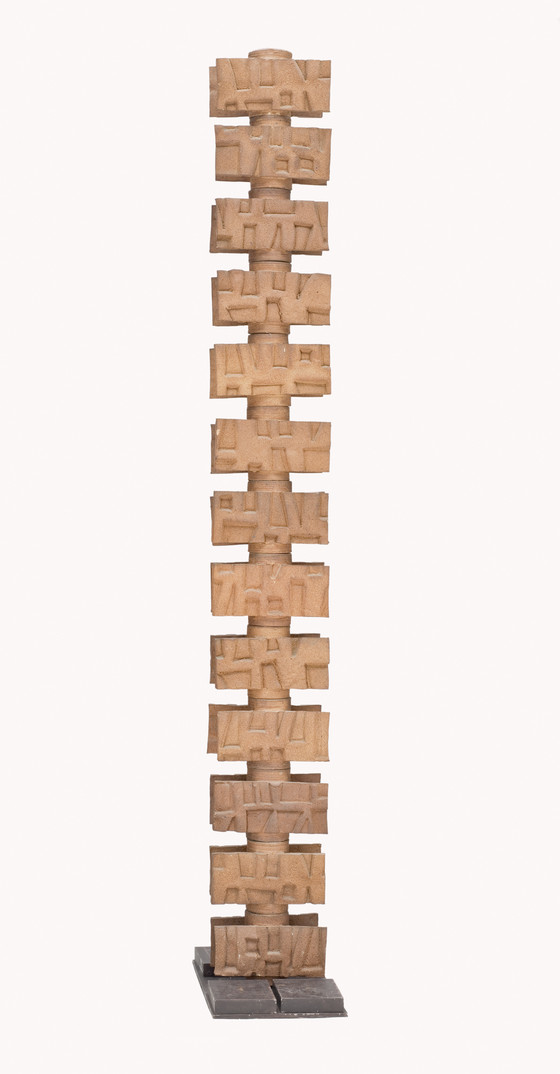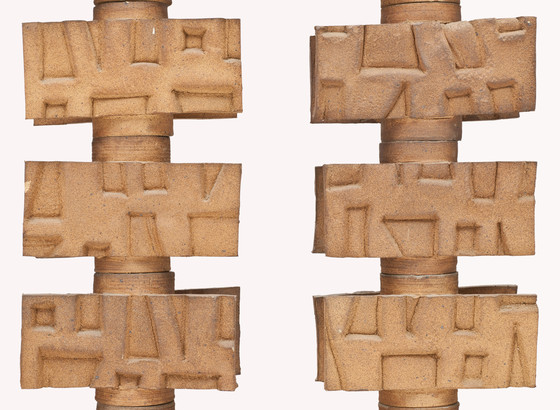Bridging the gap between hand-crafted and industrial ceramics – two fields in which post-World War II California was a leading force – the Glyph Screen Wall by Los Angeles-based artist and designer Da...
Bridging the gap between hand-crafted and industrial ceramics – two fields in which post-World War II California was a leading force – the Glyph Screen Wall by Los Angeles-based artist and designer David Cressey represents the creative fluidity that made the state an engine for innovation in the mid-twentieth century. Cressey was educated at both USC (undergraduate) and UCLA (graduate), where he studied ceramics with Vivika Heino and Laura Andreson, two of the city’s most influential ceramic artists and educators. He began his career teaching at UCLA, where he met his wife Donna, also an artist. In 1961, he was appointed chairman of the art department of Mount Saint Mary’s College in West Los Angeles, where he taught jewelry, art history, ceramics and design for several years. By this point, Cressey had developed a successful career as a studio potter, winning major awards at the Wichita National Ceramics Show, California State Fair, and First California Craft Show (among others) for the abstract sculptures, often made of constructed vessels, which he created in his Venice studio.
Shortly thereafter, Cressey left teaching to work for Architectural Pottery, a decision that dramatically shifted the course of his career and added a new dimension to a company already known for its distinct, progressive approach to design. Founded in 1950 by Max and Rita Lawrence, Architectural Pottery had made its name with a series of versatile planters and sand urns that were alternatives to the traditional terra cotta pot. Important designers, notably LaGardo Tackett, John Follis and Rex Goode, had established the company look – solid color (often white) cast earthenware in smooth geometric and subtle biomorphic shapes. In the intervening decade, the company had earned national and international recognition for its sculptural ceramics, which had been widely published and even displayed internationally.
As the first (and only) artist-in-residence at Architectural Pottery, Cressey introduced a rougher, textured aesthetic to the company’s repertoire. The catalogue for Cressey’s line, first introduced around 1963, offered both cast production pieces (including planters, fountains, screen walls and sculptures) and the opportunity to commission one-off pieces from the artist. The pieces were created from Cressey’s unique clay formula, a gritty stoneware that could be cast for bulk production. This group collectively won the 1964 American Institute of Interiors Designs International Design Award.
Initially referred to as the “Artist-in-Residence Collection,” subsequent catalogues called this the “Pro/Artisan Collection.” Both titles emphasized Cressey’s background in fine arts. Cressey, however, embraced his new role, arguing in a 1965 Los Angeles Times article that “There is no special virtue in hand-throwing, and casting allows some forms that can’t be thrown on the wheel. This frees the designer for more important work.” He remained with the company until 1976, eventually rising to a Vice President position at Group Artec (a company formed from the combination of several of the Lawrence’s smaller design companies.)
The Glyph Screen Wall was part of Cressey’s initial, award-winning collection for Architectural Pottery. Though it remained in the company catalogue for several years, these six totems come from the only known official commission, a California state government office tower on P Street in Sacramento, nicknamed the “Brown Towers” after California governor Edmund “Pat” Brown. The patterned tiles were created by pressing a large slab of clay in a sand mold and cutting it at intervals to create tiles that were each, in the words of the catalogue, “a different relief pattern, no two precisely the same, all harmoniously related.” These individual pieces were glued with slip to thrown cylinders and then mounted in columns. Cressey helped to install the dozens of columns at the site. Other examples of these tiles were installed at the Architectural Pottery showroom and in the garden of the Lawrences ’ home in Bel Air. A few extra tiles from the Sacramento commission were made into a fountain, now in the collection of Cressey’s son.
This piece embodies several important themes of California design – indoor/outdoor living, versatility, technological innovation, and the permeable boundaries between art, design and craft. Its combination of hand-crafted and machine production spoke to a desire for a class of objects that were at once tactile and unique, yet could be available to a wide consumer audience. The collaborative effort of two California design innovators, the Glyph Screen Wall is an important addition to LACMA’s collection.
Staci Steinberger, Curatorial Assistant, Decorative Arts and Design (2011)
More...



